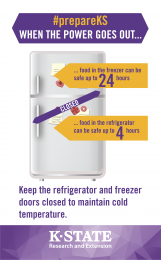September is National Preparedness Month. It is also our annual Prepare Kansas online challenge. Prepare Kansas 2019 will provide tips on keeping food safe in emergency situations. Kansans and anyone interested in planning ahead for emergencies can follow the K-State Research and Extension Facebook page and this blog at any time during September, pick up handy information and interact with K-State extension specialists and agents. No registration is required. Today’s post is written by Londa Nwadike, State Extension Consumer Food Safety Specialist for Kansas and Missouri.
Many of us living in the USA think that a power outage won’t happen to us.  Unfortunately, it can happen, so it is important to be prepared ahead of time. Power outages can be caused by the aftermath of thunderstorms, tornadoes, winter storms, floods, or a number of other reasons, making it important to be prepared anytime.
Unfortunately, it can happen, so it is important to be prepared ahead of time. Power outages can be caused by the aftermath of thunderstorms, tornadoes, winter storms, floods, or a number of other reasons, making it important to be prepared anytime.
One of the things that everyone should do to be prepared for a power outage is something that is a good food safety practice even if the power never goes out! We should all ensure that every refrigerator and freezer we use has a working thermometer in it so that if there is a power outage, you will know how warm the inside of the frig or freezer got while the power was out, so you will know if the food is safe to keep or not (more on this in upcoming weeks!). In addition, it is always important to be sure that your frig and freezer are cold enough to keep your perishable foods safe.
Refrigerators should be 40F or colder (generally from 34-40F) and freezers should be at or below 0F, both for food safety and food quality. Keeping your refrigerator below 40F will greatly reduce the likelihood that organisms such as Listeria, which can make you very sick, can grow. Listeria can grow much more rapidly at slightly higher temperatures such as 45F, so it is important to keep your refrigerator at 40F or below for safety.
Very few home refrigerators in the US actually have a thermometer in them, although most have a temperature control dial which can help to change the temperature. It is very important to know what the actual temperature in your frig is, both after a power outage and anytime! Refrigerator and freezer thermometers can be purchased at most grocery stores and discount stores for less than $5 and do not take up much room. Place one in each of your refrigerators or freezers in the spot you think would be warmest (usually the front or in the door) and move it around occasionally to be sure that the warmest spot is below 40F (refrigerator) and below 0F (freezer).
More information on important steps for food safety before a power outage is available from USDA: Keep Your Food Safe During Emergencies and Consumer Guide to Food Safety in Severe Storms and Hurricanes.





